
View of Heidelberg with the Karlsplatz in the foreground and the Neckar and the Alte Brücke (Old Bridge) in the background. (1090k)
From the Heidelberg entry in Wikipedia:
Prehistory up to Roman times:
Between 600,000 and 200,000 years ago, "Heidelberg Man" died at nearby Mauer. His jaw bone was discovered in 1907. Scientific dating determined his remains as the earliest evidence of human life in Europe. In the 5th century BCE, a Celtic fortress of refuge and place of worship was built on the Heiligenberg, or "Mountain of Saints". Both places can still be identified. In 40 CE, a fort was built and occupied by the 24th Roman cohort and the 2nd Cyrenaican cohort (CCG XXIIII and CCH II CYR). The Romans built and maintained castra (permanent camps) and a signal tower on the bank of the Neckar. They built a wooden bridge based on stone pillars across it. The camp protected the first civilian settlements that developed. The Romans remained until 260 CE, when the camp was conquered by Germanic tribes.
Middle Ages:
Modern Heidelberg can trace its beginnings to the fifth century. The village Bergheim ("Mountain Home") is first mentioned for that period in documents dated to 769 CE. Bergheim now lies in the middle of modern Heidelberg. The people gradually converted to Christianity. In 863 CE, the monastery of St. Michael was founded on the Heiligenberg inside the double rampart of the Celtic fortress. Around 1130, the Neuburg Monastery was founded in the Neckar valley. At the same time, the bishopric of Worms extended its influence into the valley, founding Schönau Abbey in 1142. Modern Heidelberg can trace its roots to this 12th-century monastery. The first reference to Heidelberg can be found in a document in Schönau Abbey dated to 1196. This is considered to be the town's founding date. In 1155, Heidelberg castle and its neighboring settlement were taken over by the house of Hohenstaufen. Conrad of Hohenstaufen became Count Palatine of the Rhine (German: Pfalzgraf bei Rhein). In 1195, the Electorate of the Palatinate passed to the House of Welf through marriage.
Modern History:
Heidelberg University played a leading part in the era of humanism and the Reformation, and the conflict between Lutheranism and Calvinism, in the 15th and 16th centuries. Heidelberg's library, founded in 1421, is the oldest existing public library in Germany. In April 1518, a few months after proclaiming his 95 Theses, Martin Luther was received in Heidelberg, to defend them. In 1537, the castle located higher up the mountain was destroyed by a gunpowder explosion. The duke's palace was built at the site of the lower castle.
Elector Frederick III, sovereign of the Electoral Palatinate from 1559 to 1576, commissioned the composition of a new Catechism for his territory. While the catechism's introduction credits the "entire theological faculty here" (at the University of Heidelberg) and "all the superintendents and prominent servants of the church" for the composition of the catechism, Zacharius Ursinus is commonly regarded as the catechism's principal author. Caspar Olevianus (1536-1587) was formerly asserted as a co-author of the document, though this theory has been largely discarded by modern scholarship. Johann Sylvan, Adam Neuser, Johannes Willing, Thomas Erastus, Michael Diller, Johannes Brunner, Tilemann Mumius, Petrus Macheropoeus, Johannes Eisenmenger, Immanuel Tremellius and Pierre Boquin are all likely to have contributed to the Catechism in some way. Frederick himself wrote the preface to the Catechism and closely oversaw its composition and publication. Frederick, who was officially Lutheran but had strong Reformed leanings, wanted to even out the religious situation of his highly Lutheran territory within the primarily Catholic Holy Roman Empire. The Council of Trent had just concluded with its conclusions and decrees against the Protestant faiths, and the Peace of Augsburg had only granted toleration for Lutheranism within the empire where the ruler was Lutheran. One of the aims of the catechism was to counteract the teachings of the Roman Catholic Church as well as Anabaptists and "strict" Gnesio-Lutherans like Tilemann Heshusius and Matthias Flacius, who were resisting Frederick's Reformed influences, particularly on the matter of Eucharist (the Lord's Supper). The Catechism-based each of its statements on biblical proof-texts, and Frederick himself would defend it as biblical, not reformed, at the 1566 Diet of Augsburg when he was called to answer to charges of violating the Peace of Augsburg. This was the Heidelberg Catechism, officially called the "Catechism, or Christian Instruction, according to the Usages of the Churches and Schools of the Electoral Palatinate."
In November 1619, the royal crown of Bohemia was offered to the Elector, Frederick V. (He was married to Elizabeth, eldest daughter of James VI and I of Scotland and England, respectively.) Frederick became known as the "Winter King", as he reigned for only one winter before the Imperial House of Habsburg regained the crown by force. His overthrow in 1621 marked the beginning of the Thirty Years' War. In 1622, after a siege of two months, the armies of the Catholic League, commanded by Johann Tserclaes, Count of Tilly, captured the town. Tilly gave the famous Bibliotheca Palatina from the Church of the Holy Spirit to the Pope as a present. The Catholic Bavarian branch of the House of Wittelsbach gained control over the Palatinate and the title of Prince-Elector. In 1648, at the end of the war, Frederick V's son Charles I Louis, Elector Palatine, was able to recover his titles and lands.
In late 1634 Imperialist forces attempted to take back the city, as the Swedish army had conquered it. They quickly took the city, but were unable to take the castle. As they prepared to blow up its fortifications with gunpowder the French army arrived, 30,000 men strong, led by Urbain de Maillé-Brézé, who had fought in many battles and participated in the Siege of La Rochelle (1627-1628), and Jacques-Nompar de Caumont, duc de La Force. They ended the siege and drove off the Catholic forces.
To strengthen his dynasty, Charles I Louis arranged the marriage of his daughter Liselotte to Philip I, Duke of Orléans, brother of Louis XIV, king of France. In 1685, after the death of Charles Louis' son, Elector Charles II, Louis XIV laid claim to his sister-in-law's inheritance. The Germans rejected the claim, in part because of religious differences between local Protestants and the French Catholics, as the Protestant Reformation had divided the peoples of Europe. The War of the Grand Alliance ensued. In 1689, French troops took the town and castle, bringing nearly total destruction to the area in 1693. As a result of the destruction due to repeated French invasions related to the War of the Palatinate Succession coupled with severe winters, thousands of Protestant German Palatines emigrated from the lower Palatinate in the early 18th century. They fled to other European cities and especially to London (where the refugees were called "the poor Palatines"). In sympathy for the Protestants, in 1709/1710, Queen Anne's government arranged transport for nearly 6,000 Palatines to New York. Others were transported to Pennsylvania, and to South Carolina. They worked their passage and later settled in the English colonies there.
In 1720, after assigning a major church for exclusively Catholic use, religious conflicts with the mostly Protestant inhabitants of Heidelberg caused the Roman Catholic Prince-Elector Charles III Philip to transfer his residence to nearby Mannheim. The court remained there until the Elector Charles Theodore became Elector of Bavaria in 1777 and established his court in Munich. In 1742, Elector Charles Theodore began rebuilding the Palace. In 1764, a lightning bolt destroyed other palace buildings during reconstruction, causing the work to be discontinued.
1803 to 1933:
Heidelberg fell to the Grand Duchy of Baden in 1803. Charles Frederick, Grand Duke of Baden, re-founded the university, named "Ruperto-Carola" after its two founders. Notable scholars soon earned it a reputation as a "royal residence of the intellect". In the 18th century, the town was rebuilt in the Baroque style on the old medieval layout.
In 1810, the French revolution refugee Count Charles Graimberg began to preserve the palace ruins and establish a historical collection. In 1815, the Emperor of Austria, the Emperor of Russia and the King of Prussia formed the "Holy Alliance" in Heidelberg. In 1848, the German National Assembly was held there. In 1849, during the Palatinate-Baden rebellion of the 1848 Revolutions, Heidelberg was the headquarters of a revolutionary army. It was defeated by a Prussian army near Waghäusel. The city was occupied by Prussian troops until 1850. Between 1920 and 1933, Heidelberg University became a center of notable physicians Czerny, Erb, and Krehl; and humanists Rohde, Weber, and Gandolf.
Nazism and the World War II-period:
During the Nazi period (1933-1945), Heidelberg was a stronghold of the NSDAP, (the National Socialist German Workers' Party) the strongest party in the elections before 1933 (the NSDAP obtained 30% at the communal elections of 1930). The NSDAP received 45.9% of the votes in the German federal election of March 1933 (the national average was 43.9%). Non-Aryan university staff were discriminated against. By 1939, one-third of the university's teaching staff had been forced out for racial and political reasons. The non-Aryan professors were ejected in 1933, within one month of Hitler's rise to power. The lists of those to be deported were prepared beforehand.
In 1934 and 1935, the Reichsarbeitsdienst (State Labor Service) and Heidelberg University students built the huge Thingstätte amphitheater on the Heiligenberg north of the town, for Nazi Party and SS events. A few months later, the inauguration of the huge Ehrenfriedhof memorial cemetery completed the second and last NSDAP project in Heidelberg. This cemetery is on the southern side of the old part of town, a little south of the Königstuhl hilltop, and faces west towards France. During World War II and after, Wehrmacht soldiers were buried there. Memorial stone marking the site of the synagogue in the Lauerstrasse
On March 29, 1945, German troops left the city after destroying three arches of the old bridge, Heidelberg's treasured river crossing. They also destroyed the more modern bridge downstream. The U.S. Army (63rd Infantry, 7th Army) entered the town on March 30, 1945. The civilian population surrendered without resistance.
A popular belief is that Heidelberg escaped bombing in World War II because the U.S. Army wanted to use the city as a garrison after the war. As Heidelberg was neither an industrial center nor a transport hub, it did not present a target of opportunity. Other notable university towns, such as Tübingen and Göttingen, were spared bombing as well. Allied air raids focused extensively on the nearby industrial cities of Mannheim and Ludwigshafen.
The U.S. Army may have chosen Heidelberg as a garrison base because of its excellent infrastructure, including the Heidelberg-Mannheim Autobahn (motorway), which connected to the Mannheim-Darmstadt-Frankfurt Autobahn, and the U.S. Army installations in Mannheim and Frankfurt. The intact rail infrastructure was more important in the late 1940s and early 1950s when most heavy loads were still carried by train, not by truck. Heidelberg had the untouched Wehrmacht barracks, the "Grossdeutschland Kaserne" which the US Army occupied soon after, renaming it the Campbell Barracks.
In 1945, the university was reopened relatively quickly on the initiative of a small group of professors, among whom were the anti-Nazi economist Alfred Weber and the philosopher Karl Jaspers. The surgeon Karl Heinrich Bauer was nominated rector.
All pictures are © Dr. Günther Eichhorn, unless otherwise noted.





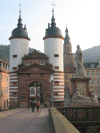
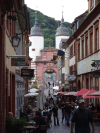
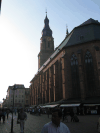
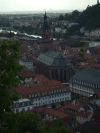
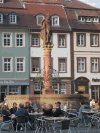
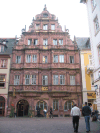
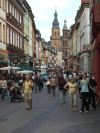
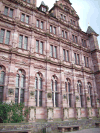
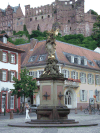

This page contains 15 pictures

Main page for Deutschland (Germany)
Page last updated on Fri Nov 5 13:55:21 2021 (Mountain Standard Time)
Page last updated on Wed Apr 24 22:00:10 2024 (Mountain Standard Time)
Heidelberg on soaring.geichhorn.com